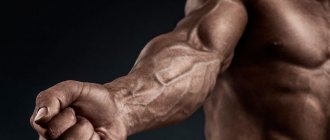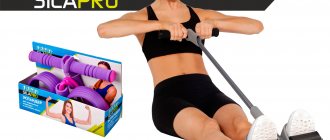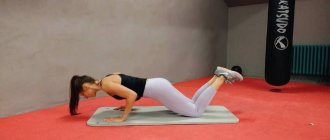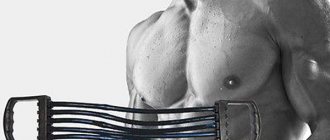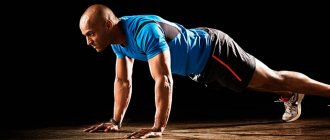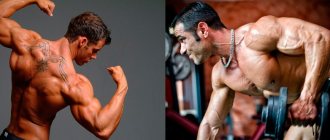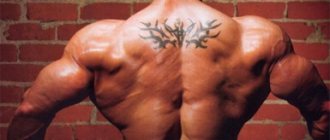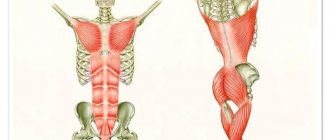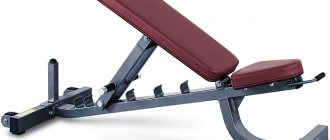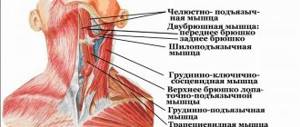Good day, in this article we will look at training the muscles of the forearms in street and home conditions, create a training program, and also analyze all types of the most effective exercises for this muscle group, using rubber loops, a towel and just a regular horizontal bar.
The muscles of the forearm are divided into posterior and anterior groups, each of which has a superficial and deep layer. The main muscles here are: flexors + extensors, as well as the brachioradialis muscle. There are five main functions of the forearms: extension, flexion, outward and inward rotation (the so-called pronation and supination), as well as compression.
In order for your forearms to be not only large, but also functionally strong, you need to train them not only in dynamic mode, but also in isometric mode, i.e. perform their main function. In this case, any hanging, holding various objects will be much more useful in this regard than any bending and extension with a barbell or dumbbells in the gym.
Let's take an example of all the types of best exercises for the forearm muscles that you can use in your arsenal.
Anatomical features
The part of the human arm from the hand to the elbow is called the forearm, consisting of several muscles that are called "stubborn" because of their resistance to physical stress:
- brachialis (shoulder muscle);
- pronator teres;
- brachioradialis (brachioradialis muscle);
- flexors;
- extensors.
Such muscles are considered “small.” They are responsible for flexion, extension, and rotation of the arms at the elbow and wrist joints. “Pumping up” “stubborn” muscles is quite a difficult task for any athlete, since they have a unique and complex structure. The training process involves working all five muscles of this group for their uniform development.
I have a separate article on the topic of hand anatomy on my blog. There is separate information about the forearms, more complete. I'm sure it will be useful to you.
A little theory and useful tips
To begin with, I would like to say that the forearms are a small muscle group and it does not need too much separate training. Why?
Mainly because during training of small muscle groups in our body there is a very small release of anabolic hormones into the blood. When we train large muscle groups (chest, back, legs), this puts powerful stress on the body and more hormones enter the bloodstream for subsequent growth.
This “infusion” is quite enough for the growth of small muscle groups, such as calves and forearms. Therefore, if you are a beginner, then there is no point in hammering your forearms hard and in a separate workout. Focus on basic exercises, develop large muscle groups, and leave small ones for later, when you gain experience and have already formed a decent muscle base.
How often should you train your forearms?
Personally, I have never trained this muscle group more than once a week and I don’t plan to do it more often. For me, once is it.
You just need to understand that these are the same muscles as the biceps and triceps. It grows and recovers according to the same principles. That is, you must determine for yourself the amount of training that you will give them.
Some pros don’t train them at all, because after pumping up their biceps, they’ve already worked them hard.
Subtleties of the workout itself
AMPLITUDE.
As for the technical subtleties of performing the exercises, it is important to mention the range of movements. Since it is short in all forearm exercises, the number of repetitions can be increased. I usually do 15-20 times. After 15 times I always feel a strong burning sensation and I don’t always pull it out until 20. Sometimes I do just 10 reps, but with a heavier weight.
"REFUSAL".
I also wanted to say that your muscles must be in a state of “failure” in order for them to grow. That is, your last repetitions should deplete the fibers so much that you can no longer complete a single repetition fully.
The brutal guys in my gym, when they reached this state in forearm training, simply threw the barbell or dumbbell on the floor and could no longer hold it. I didn’t really like this, since I was used to always carefully putting the projectile in place, but the point is that this is a state of failure. Yes, and if you throw shells on the floor, first make sure that they will not “clack” on the concrete floor))).
COMBINATION WITH BICEPS.
Train your forearms along with your biceps on the day you pump them up. Always train after the biceps, because if it’s the other way around, it may turn out that if you train a small muscle group (forearms), you can screw up pumping the large one (biceps). And this is fundamentally wrong! Large groups always train first and are given priority.
A little anatomy
As you can see, the forearm is made up of dozens of small muscles. Only the main ones are labeled in the picture. All the muscles that move the hand and fingers in one way or another are located in this area. Each hand has 5 fingers. Each finger moves approximately the same number of muscles. Plus also the muscles that move the hand. So it turns out - several dozen thin muscles in one area.
That is, to pump up your forearm you need to train not only your hands, but also your fingers. I think this is clear. Now let's look at each exercise in detail. And let's start with the fingers.
The most effective exercises for the gym
I only practice 4 forearm exercises in the gym. I don't use the rest at all. Here they are:
- Raising the barbell for biceps with a reverse grip. Perfectly works the largest muscle of the forearm - the brachioradialis.
- "Hammers" with dumbbells. One of my favorite exercises, although I don’t really like the “woody” feeling in the trained muscle at the end of the approach.
- Curling barbells or dumbbells while sitting on a bench. But sometimes I didn't even use the bench. The guys in my gym always made me laugh. I just took the barbell, put it on my lap and then leaned my body back a little. The weight of the bar in front of me kept me from falling on my butt. From the outside it looks like I’m sitting on an invisible bench - it turns out cool. So over time I stopped using the bench. This exercise works the elbow and shoulder flexors.
- Barbell extensions with a reverse grip while sitting. This is the exercise I practice least often.
I think these are the most effective exercises. And that's how they really are. I wasn’t interested in others, because I don’t need it, to be honest. They are shown clearly in the pictures below.
FOREARM EXERCISES WITH BARBERLESS AND DUMBBELLS
The standing barbell reverse curl is a conditioning exercise that targets the outer forearm muscles, specifically the brachioradialis. The load also falls on the brachialis and biceps.
Wrist curls with a barbell especially stimulate the development of the inner surface of the forearm muscles. The exercise loads the radial and ulnar flexors of the wrists, long palmaris muscles, deep and superficial flexors of the fingers.
Barbell wrist extensions work the large muscles on the outer forearms, especially the brachioradialis muscles. The work involves the extensor carpi radialis brevis and longus, the extensor digitorum, the extensor of the little finger, and the extensor carpi ulnaris.
Hammer curls are considered to be formative for the arm muscles. It affects the lateral (outer) head of the biceps and works well on the brachialis. The load also falls on the outer part of the forearm, the brachioradialis muscle.
For barbell exercises, the barbell can be replaced with dumbbells. In cases with wrist extension and flexion, it will be more effective to perform the exercise with each arm separately.
Other impact options
Here I want to draw attention to those exercises, the implementation of which greatly affects the forearms, although they are not targeted for them. You may want to include some of them in your “rocking” diet.
"FARMER'S WALK".
This exercise allows you to work the muscles of your upper body. Involves the use of dumbbells or weights. From a straight stance with dumbbells in your arms, you need to start walking with your chest and shoulders raised, tensing your abs.
Perform 3-4 approaches of 14-15 meters. The Farmer's Walk allows you to warm up your entire body and then move on to continue your training process. The weight of weights and dumbbells is selected individually. The execution time can be varied depending on the athlete’s well-being. Grip strength will definitely increase as heavy weights will be used.
"TRAP GRIF".
Another type of “walk” is training with a trap bar. It is important that your hands are not wet or slippery. The weight chosen is different for each approach. The trap bar needs to be lifted and slowly carried over a distance of 9-10 meters. 3-4 approaches are performed. You can carry a bar with a large weight for a maximum distance. This will allow you to pump up almost your entire body, but especially your arms.
You can see what this strange neck looks like in the picture below. The person is inside it.
“JURK-HOLD.”
An excellent tool for working with “stubborn” muscles can be a kettlebell, with which you can lift (jerk) with one hand. The weight is lifted up with its base and held for several seconds above the head at arm's length. Recommendations for the number of approaches: 3×10 repetitions.
BENDING BEHIND THE BACK ON THE LOWER BLOCK.
It is necessary, standing with your back, take the handle with the cable in your hand and move away from the simulator as far as possible so that the cable is stretched all the way and your hand is pulled back. For balance, your left leg should be slightly forward. In this position, you need to pull your hand forward. The movements are performed at least 3 approaches 12 times.
CABLE PULLING ON A TRAINING MACHINE.
The best way to do this is to wrap a towel around the cable pulley. You need to take the ends of the towel in your hands and then pull them towards your chest, squeezing your shoulder blades. After 3 sets of 10 repetitions, you will feel “clogged” in the arm muscles. The exercise can be performed both standing and sitting.
SCOTT BENCH AND EZ-BAR.
Training on the Scott bench has an excellent effect on the muscles of the forearms. It consists of bending the EZ bar while sitting at a comfortable height. At the same time, the armpits are close and touch the bench, and the hands are positioned shoulder-width apart. The bar bends towards the bench and then returns to its original position. The back must be straight. Three sets of six repetitions each will give the desired load.
TRAINING YOUR GRIP STRENGTH WITH A DUMBBELL.
Training to strengthen your grip with dumbbells takes place while sitting. The hand is placed on the surface of the thigh, then the dumbbell is rolled onto the fingertips of the open palm. Next, squeeze your hand tightly and twist your wrist, tightly squeezing the load. It is better to perform the movements slowly, alternately working with your right or left hand. It is recommended to perform the movements 4×10 times.
USING GRIP EXTENSIONS.
There are special things that are placed on the barbell and dumbbell handle in order to thicken the girth. The thicker the bar, the more difficult it is to hold and the more the forearms are activated. They look like this:
If they are not there, then using a towel, for example, you can add dumbbell grip thickness to perform a dumbbell row exercise with emphasis on a bench. A thicker bar stimulates the forearm muscles more, especially if you do 3 sets of 10 reps.
PRONATION-SUPINATION DURING LIFTING DUMBBELLS.
Pronation and supination are terms for the position of your palm relative to its axis, which changes as it rotates. To figure out what's where, do this. Place your palm with its edge relative to the surface of the earth. Now turn your palm so that the inside of it faces the sky - this is supination. When the inside of the palm faces the floor, this is pronation.
How can we use this in combination with dumbbell lifting? Easily!
- If you lift a dumbbell with your palm facing up (classic grip), then you pronate at the very top of the lift. You will need a pause to crank.
- If you do dumbbell lifts with an overhand grip, then at the top point you do supination.
The barbell should be raised to such a height that the muscles of the biceps and forearm do not turn off, with a delay of several seconds on the weight. The return stroke is also slow. Quantitatively, 3x8 movements should be performed.
HAMMER STYLE CROWS.
There is a technique that perfectly develops the muscles of the arms - this is twisting the wrists, when the thumb is at the top and there is a dumbbell in the hand. This exercise is called the hammer crunch. It is performed while sitting on a bench, holding your hand on your hip and working your hand back and forth, as if driving nails. This workout works well for the brachioradialis muscle. Repeats 3x8-10 times.
You are in the section:
Sports and beauty > Articles for men > How to pump up forearm muscles for men at home
Are you wondering how to pump up forearm muscles for men at home and what is it for? Let's figure out together why this is needed and what needs to be done for this.
It’s always interesting to watch how some people bend nails and fittings with their hands, open cans with their hands and roll frying pans into tubes. And it is not the biceps and triceps that are responsible for this strength, but the muscles of the forearm.
Many gym clients ignore working out the forearm muscles, which is absolutely not true. It is clear that when pumping the main muscles, these muscles are involved in work, but this is not enough for their growth and strength, as a result, the appearance is not aesthetic.
Dumbbells, cylinders with water or sand are perfect for training at home, and if you find a barbell with weights, then you are guaranteed Papaya hands.
